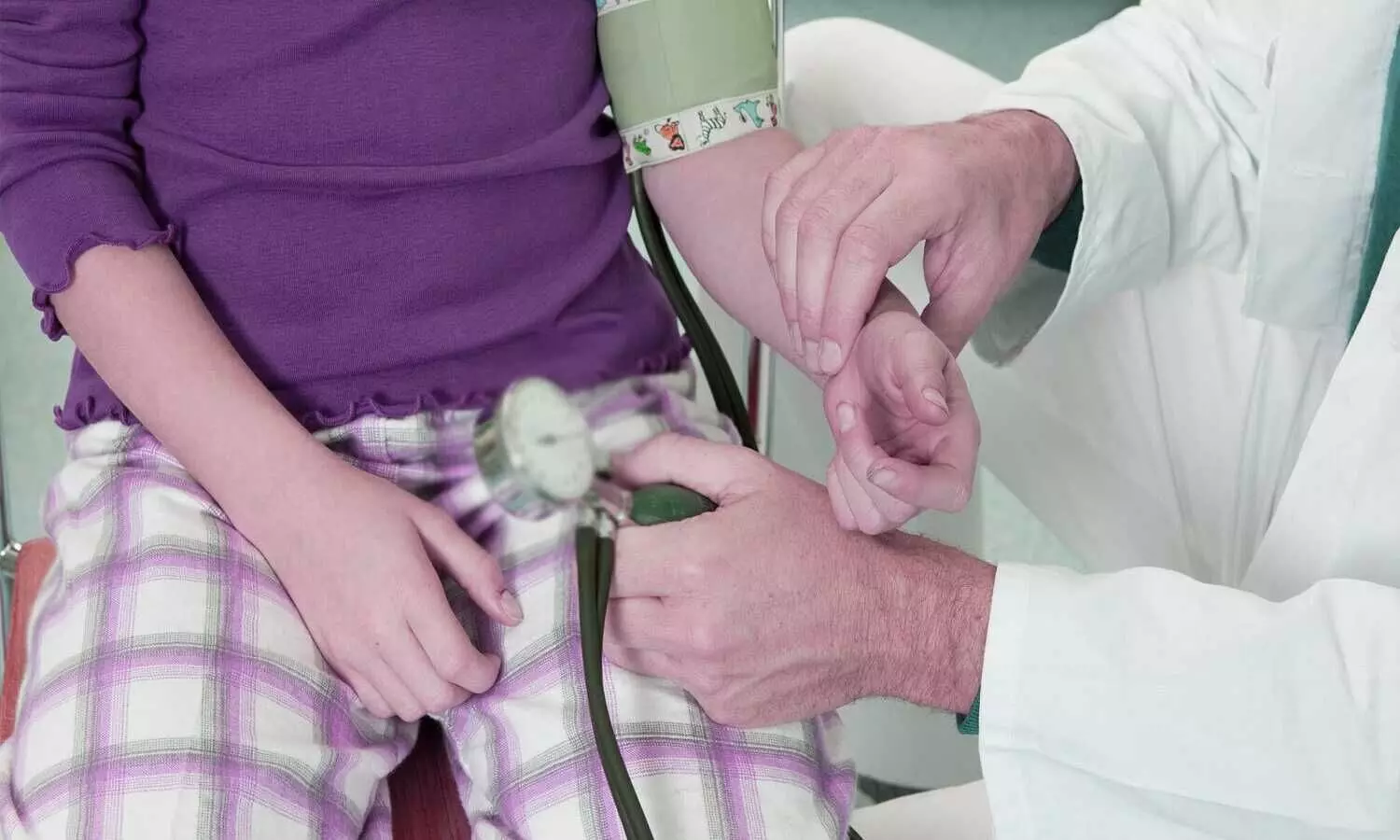Advanced bladder cancer patients with alterations in FGFR3 gene respond well to investigational drug: Clinical trial
Powered by WPeMatico
Powered by WPeMatico
Powered by WPeMatico
Powered by WPeMatico
Powered by WPeMatico

Chandigarh: Witnessing a series of attacks and violence against doctors at government medical colleges and hospitals which has increased after the RG Kar incident, the the Punjab Civil Medical Services (PCMS) is on the verge of agitation.
Despite receiving assurances from the AAP-led Punjab Government for enhanced security and implementation of the Dynamic Assured Career Progression (DACP) scheme, the doctors received no tangible action from the government. Therefore, the doctors are now planning to follow the path of agitation.
In the last two months, more than a dozen assaults have been reported at government health facilities across Punjab, most recently at the Civil Hospital in Jalandhar and the Community Health Centre (CHC) in Dhakoli while others are at Dera Baba Nanak, Patiala, Jagron, Sunam, Rajpura, Ferozepur and Naushera Majha Singh.
Also read- Punjab doctors end strike after State Government’s assurance
On October 20, an intoxicated man assaulted a doctor on night duty and harassed a female colleague at Jalandhar’s civil hospital. That same night, two groups clashed at the community health centre (CHC) in Dhakoli, forcing a woman doctor and staff to lock themselves in a room for safety until police arrived.
After the intervention of the association in the incidents, the state police lodged the cases against the alleged accused under Bharatiya Nyaya Sanhita and the Punjab Protection Medicare Services Institutions (Prevention of Violence and Damage of Property) Act.
Speaking to TNIE, Dr Akhil Sarin, president of the Punjab Civil Medical Services (PCMS) Association of Punjab said, “If commitment made by the government is not met within the stipulated time frame then the doctors will be forced to follow the path of agitation. On October 21, a letter was written to the state health and family welfare secretary requesting a meeting regarding a review of the implementation of security provisions.”
“On September 11 the association met with the cabinet subcommittee and received a written assurance that a comprehensive security framed work at all the 24/7 centres of the state would be put in place within a week of the meeting and also the government agreed to the implementation of dynamic assured carrier progressions (DACPs) within 12 weeks of the meeting but nothing happened on the ground,’’ he added.
Medical Dialogues had earlier reported that a protest began on September 9 where the doctors suspended outpatient department services across all government facilities. However, the Punjab Civil Medical Services Association (PCMSA) called off its ongoing strike after the state government accepted their demand.
“After the meeting, the state health minister announced and reiterated that the assurances will be implemented within the stipulated time frame. However even after the lapse of six weeks, no on-ground steps for implementation of the assurances are perceptible,” Dr Akhil added.
Powered by WPeMatico

Coronary artery disease (CAD) is a significant group within cardiovascular diseases (CVD) that results from decreased myocardial perfusion, leading to conditions such as angina, myocardial infarction (MI), and/or heart failure (1).
Hypertension and dyslipidemia are two major contributing risk factors for CVD. The reported prevalence of their co-existence ranges from 15% to 31%. This co-existence has an additive adverse impact on vascular endothelium, enhancing atherosclerosis and increasing the risk of CVD (2).
As per the World Health Organization, India accounts for one-fifth of cardiovascular (CV) deaths worldwide, especially in the younger population. Among all risks for cardiovascular diseases, high systolic blood pressure accounted for the largest proportion of disability-adjusted life years. Indians are liable to get hospitalized 2–4 times more frequently for complications of CAD. (3)
The ideal approach for CVD management is detecting and reducing risk, managing events, and preventing the progression of disease and recurrence of CVD (4). Therefore, the utmost importance is to manage hypertension and dyslipidemia to combat CVD risk. European Society of Hypertension Clinical Guidelines 2024 recommends the use of angiotensin-converting enzyme inhibitors (ACEi), angiotensin II receptor blockers (ARBs), calcium channel blockers (CCBs), diuretics, and beta-blockers for the management of hypertension. (5)
Beta-blockers in CV Care:
Beta-blockers have been used for treating various CVDs. They act by inhibiting the effects of catecholamines via multiple pathways that affect myocardial chronotropy, inotropy, and renin release with anti-ischemic and anti-arrhythmic effects, therefore reducing myocardial oxygen consumption and decreasing heart rate and blood pressure. (6).
Beta‐1 selective blockers lowered systolic blood pressure (SBP) by a similar degree and lowered diastolic blood pressure (DBP) by a greater degree than diuretics, angiotensin-converting enzyme inhibitors, and angiotensin receptor blockers. (6)
Metoprolol Use in Cardiovascular Disease Conditions:
Metoprolol is a cardioselective beta-blocker medication that acts on the beta-1 adrenergic receptors in the heart and reduces the effects of catecholamines (such as adrenaline and noradrenaline) on cardiac function. (7) The American Heart Association (AHA) guidelines recommend the use of agents, including beta-blockers, to prevent the progression of congestive heart failure. Three beta-blockers have been shown to reduce the risk of death in patients with congestive heart failure- metoprolol, bisoprolol, and carvedilol. (8) Based on a recently published 2024 expert opinion from Indian cardiologists, among beta-blockers, metoprolol is the first treatment choice for post-percutaneous coronary intervention (PCI) and heart failure patients. (9)
Considering Metoprolol in Hypertension:
European Society of Hypertension (ESH) clinical guidelines 2024 suggest the use of beta-blockers in hypertension associated with CAD and heart failure with poor ejection fraction as first-line therapy and in chronic kidney disease and true resistant hypertension as an add-on therapy. (5)
A systematic review including nine randomized controlled trials (RCTs) examined the blood pressure lowering efficacy of 25 mg to 400 mg per day metoprolol in 1004 hypertensive participants. All metoprolol doses significantly lowered SBP and DBP compared to placebo. The estimate of the blood pressure-lowering effect of metoprolol was ‐9/‐8 mmHg. (10)
Indian consensus as per the Journal of the Association of Physicians of India 2024, Beta-blockers can be considered in the treatment of hypertension and hypertension with comorbid disorders, such as MI, heart failure with reduced ejection fraction(HFrEF), and atrial fibrillation(AF). Patients with high resting heart rates who have hypertension, including younger hypertensives under 40, should be prescribed beta-blockers. (11)
A recent 2021 study comparing bisoprolol and metoprolol in hypertension highlights that both molecules are equally effective in controlling blood pressure and heart rate and were also similar with respect to efficacy and tolerability on Global Assessment by both doctors & patients. (12)
Use of Metoprolol in Left Ventricular Dysfunction:
Left-ventricular (LV) hypertrophy is often associated with arterial hypertension, impaired LV myocardial contractility, and LV diastolic dysfunction. Goldstein S et al. conducted a study including 60 patients with LV dysfunction were randomly assigned to either metoprolol succinate group or placebo for 6 months and concluded that treatment with metoprolol succinate is safe and well tolerated and associated with an increase in LV ejection fraction and a decrease in ventricular ectopic beats. (13)
The Randomized Evaluation of Strategies for Left Ventricular Dysfunction (RESOLVD) trial assessed the effects of adding metoprolol succinate or placebo to symptomatic heart failure patients who had received treatment with either an ACEi (enalapril), an ARB (candesartan), or both for 5 months (plus a diuretic in 84% of patients). After 24 weeks of treatment, patients randomized to metoprolol experienced a 53% decrease in mortality compared with a regimen that did not include a beta-blocker. Importantly, adding metoprolol to either enalapril, candesartan, or both resulted in significantly improved LV volumes and ejection fraction. (14)
Application of Metoprolol Post-Acute Myocardial Infarction:
Metoprolol has become part of recommended therapy in acute myocardial infarction in recognition of its significant effect on mortality reduction with less risk of worsening heart failure. In a study published in Frontiers of Cardiovascular Medicine 2021, patients receiving metoprolol treatment following PCI-related periprocedural myocardial infarction decreased subsequent risk of major cardiovascular adverse events (MACE) by 7.1% and revascularization by nearly 5.5%. (15)
Scope of Metoprolol in Congestive Heart Failure:
As per the metoprolol randomized intervention trial in congestive heart failure (MERIT-HF), 34% reduction in total mortality in the metoprolol controlled/extended release group compared with the placebo group. Total mortality or hospitalization for worsening heart failure was reduced by 31%. (16)
Summary:
References:
1. Edgardo Olvera Lopez et al. Cardiovascular Disease. Stat Pearls Publishing 2024. Bookshelf ID: NBK535419PMID: 30571040
2. MUTHUSAMY, V.V.. BR 08-3 MANAGEMENT OF DYSLIPIDEMIA IN HYPERTENSION. Journal of Hypertension 34():p e545, September 2016. | DOI: 10.1097/01.hjh.0000501492.32355.c5
3. A Sreenivas kumar et al. Cardiovascular disease in India: A 360-degree overview. Med J Armed Forces India 2020; 76(1); PMC6994761
4. Promoting Cardiovascular Health in the Developing World: A Critical Challenge to Achieve Global Health. Washington (DC): National Academies Press (US); 2010. ISBN-13: 978-0-309-14774-3
5. 2024 European Society of Hypertension clinical practice guidelines for the management of arterial hypertensionEndorsed by the European Federation of Internal Medicine (EFIM), European Renal Association (ERA), and International Society of Hypertension (ISH).
6. Saumrita Ray et al. Role of β-blockers in the cardiovascular disease continuum: a collaborative Delphi survey-based consensus from Asia-Pacific. Current Medical Research and Opinion 2023; 39(12), 1671–1683.
7. Jason Morris et al. Metoprolol. Stat Pearls Publishing 2024. Bookshelf ID: NBK532923PMID: 30422518
8. Writing Committee Members. and ACC/AHA Joint Committee Members. “2022 AHA/ACC/HFSA Guideline for the Management of Heart Failure.” Journal of cardiac failure vol. 28,5 (2022): e1-e167. doi:10.1016/j.cardfail.2022.02.010
9. Kumar, Arram Sreenivas; Kumar, Viveka; Shah, Chetan P; Kasturi, Sridhar; Birla, Ashish; Revankar, Santosh; Yadav, Neeraj Kumar. Hypertension Management in Pre- and Post-Percutaneous Coronary Intervention Patients: An Expert Opinion of Cardiologists from India. Journal of the Practice of Cardiovascular Sciences. 2024;10(1):18-24.
10. Gavin WK Wong et al. Blood pressure lowering efficacy of beta‐1 selective beta blockers for primary hypertension. Cochrane Database Syst Rev. 2016 Mar; 2016(3): CD007451.
11. J C Mohan et al. Position of Beta-blockers in the Treatment of Hypertension Today: An Indian Consensus. J of the Asso of Phy of India 2024; 72(10): 83-90.
12. A Dasbiswas et al. Efficacy & tolerability of bisoprolol in comparison to metoprolol in Indian patients with stage-1 hypertension: a multicentre, parallel-group, open-labeled, randomized noninferiority clinical study. European Heart Journal 2021. 42(suppl 1).
13. Sidney Goldstein et al. Metoprolol CR/XL in patients with heart failure: A pilot study examining the tolerability, safety, and effect on left ventricular ejection fraction. Am H Jour 1999; 138(6): 1158-65.
14. R E Willams. Early Initiation of β Blockade in Heart Failure: Issues and Evidence. J Clin Hypertens (Greenwich) 2005; 7(9); PMC8109715
15. Duanbin Li et al. Effects of Metoprolol on Periprocedural Myocardial Infarction After Percutaneous Coronary Intervention (Type 4a MI): An Inverse Probability of Treatment Weighting Analysis. Fron Cardiovas Med 2021;8: 746988
16. O D Freitas et al. The use of metoprolol CR/XL in the treatment of patients with diabetes and chronic heart failure. Vasc Health Risk Manag 2006;2(2):139-44
Powered by WPeMatico

Manesar: HSCC (India) Ltd, a subsidiary of state-owned NBCC, has secured contracts worth Rs 1,322.48 crore from the Employees State Insurance Corporation (ESIC). The projects include constructing a new hospital in Manesar, Haryana, and adding 500 beds to the existing facility in Faridabad.
According to the PTI report, in a regulatory filing on Tuesday, NBCC informed that HSCC (India) Limited, its wholly-owned subsidiary, has bagged two contracts from Employees State Insurance Corporation with a combined value of Rs 1,322.48 crore.
Also Read:ESIC Hospital Hyderabad perform first in-house cadaver organ retrieval, Gives new life to three
HSCC will construct additional 500 beds, with enhancement of bed strength from 650 to 1,150 beds, at ESIC Medical College and Hospital at Faridabad on a deposit mode basis. The value of the work is Rs 642.69 crore.
It will also construct a 500-bedded ESIC Hospital at Manesar (Gurugram), Haryana on a deposit mode basis. The value of work order is Rs 679.79 crore, news agency PTI reported.
NBCC is into project management consultancy and real estate businesses.
Also Read:NBCC to build new medical college and 430 bedded hospital in Maharashtra
Powered by WPeMatico

USA: The European Society of Cardiology (ESC) has unveiled its 2024 guidelines for managing elevated blood pressure (BP) and hypertension, emphasizing a patient-centered approach developed by a multidisciplinary team. The guidelines, often referred to as the “Ten Commandments,” aim to improve cardiovascular health across Europe.
The guidelines were published online in the European Heart Journal on October 16, 2024.
Blood Pressure Classification
A notable change in the guidelines is the introduction of a new classification system. Blood pressure is categorized as:
This clear classification helps clinicians better understand and manage their patients’ conditions.
Diagnosis Recommendations
The guidelines recommend out-of-office BP measurements, such as home monitoring, as the preferred method for diagnosing elevated BP and hypertension. This approach allows for more accurate readings than traditional office measurements, which can be influenced by “white coat syndrome.”
Risk Assessment Protocols
Effective risk assessment is crucial for individuals with elevated BP. The guidelines outline a step-wise approach:
This comprehensive risk assessment helps identify high-risk patients who may benefit from more aggressive management.
Management Strategies
For individuals with elevated BP and low CVD risk, lifestyle changes are recommended. These may include increased physical activity, dietary modifications, and weight management. For those with elevated BP and high CVD risk, initial lifestyle measures are also recommended, followed by pharmacological treatment if BP remains elevated after three months.
In cases of established hypertension, the guidelines advocate for both lifestyle modifications and medication. An initial approach using single-pill double combination therapy is suggested for most patients, facilitating better adherence and control.
Lifestyle Management Recommendations
The updated lifestyle recommendations encourage:
These lifestyle changes are crucial for managing blood pressure and improving overall health.
Target Blood Pressure Goals
For patients undergoing treatment, the guidelines recommend a target systolic BP of 120–129 mmHg. In older individuals, particularly those over 85, or those with specific health challenges, a more flexible target is advised—aiming for the lowest BP achievable without causing adverse effects.
Addressing Resistant Hypertension
For patients with resistant hypertension, the guidelines recommend the use of spironolactone or eplerenone as first-line treatments, followed by beta blockers and other medications as needed. Renal denervation is also an option for some patients.
Multidisciplinary Approach
Finally, the guidelines stress the importance of a multidisciplinary team approach in managing BP. This includes delegating responsibilities away from physicians to improve overall care and control elevated blood pressure.
In summary, the 2024 ESC guidelines for managing elevated blood pressure and hypertension provide a comprehensive framework aimed at improving patient outcomes through a combination of lifestyle changes, personalized treatment plans, and a collaborative healthcare approach.
Reference:
McCarthy, C. P., Touyz, R. M., & McEvoy, J. W. The ‘ten commandments’ for the 2024 European Society of Cardiology guidelines on elevated blood pressure and hypertension. European Heart Journal. https://doi.org/10.1093/eurheartj/ehae646
Powered by WPeMatico

USA: A recent SMART randomized clinical trial analysis has revealed significant findings regarding Transcatheter Aortic Valve Replacement (TAVR) for women suffering from severe symptomatic aortic stenosis and small aortic annuli.
The study, published in JAMA Cardiology, revealed that the use of self-expanding valves (SEVs) showed comparable clinical outcomes to balloon-expandable valves (BEVs) while significantly decreasing the occurrence of bioprosthetic valve dysfunction over 12 months.
The researchers note that historically, women with aortic stenosis have faced poorer outcomes and less recognition than men, often being underdiagnosed and undertreated. Additionally, they have been underrepresented in clinical trials, further complicating their treatment and care. Considering this, Didier Tchétché, Department of Interventional Cardiology, Clinique Pasteur, Toulouse, France, and colleagues aimed to assess whether women with small aortic annuli undergoing transcatheter aortic valve replacement achieve improved clinical and hemodynamic outcomes with SEVs compared to BEVs.
The Small Annuli Randomized to Evolut or SAPIEN Trial (SMART) was a large randomized clinical trial examining patients with small aortic annuli undergoing transcatheter aortic valve replacement. Seven hundred sixteen patients were randomized to receive self-expanding or balloon-expandable valves at 83 centers across Canada, Europe, Israel, and the US from April 2021 to October 2022. This analysis focuses on the clinical and hemodynamic outcomes of the 621 women enrolled in SMART, with data analyzed from February to April 2024.
The intervention involved transcatheter aortic valve replacement using either SEVs or BEVs. The primary clinical outcome was a composite measure of death, disabling stroke, or heart failure-related rehospitalization, while the primary valve function outcome assessed the incidence of bioprosthetic valve dysfunction over 12 months. Secondary outcomes included the rate of moderate or severe prosthesis-patient mismatch.
The following were the key findings of the study:
“Our findings showed that in women with small aortic annuli undergoing TAVR, the use of self-expanding valves led to comparable clinical outcomes and improved hemodynamic performance compared to balloon-expandable valves,” the researchers concluded.
Reference:
Tchétché D, Mehran R, Blackman DJ, et al. Transcatheter Aortic Valve Implantation by Valve Type in Women With Small Annuli: Results From the SMART Randomized Clinical Trial. JAMA Cardiol. Published online October 09, 2024. doi:10.1001/jamacardio.2024.3241
Powered by WPeMatico

USA: A recent study from the Study of Women’s Health Across the Nation (SWAN) has shed light on the relationship between diabetes, insulin resistance, and the prevalence of uterine fibroids in midlife women.
The study revealed that the impact of diabetes and certain biomarkers on fibroids can differ based on menopausal status. Specifically, they found that the risk of fibroids may rise with insulin resistance but decrease with effective diabetes treatment. The findings were published online in The Journal of Clinical Endocrinology & Metabolism.
“Individuals with diabetes experienced a 28% lower occurrence of uterine fibroids, particularly among those taking metformin,” the researchers reported. “Our findings provide preliminary evidence suggesting a protective relationship between diabetes and the risk of developing new fibroids.”
Uterine fibroids, non-cancerous growths in the uterus, are common among women, particularly during their reproductive years. However, their diagnosis can have profound implications for overall health, especially as women transition into menopause. Susanna D Mitro, Division of Research, Kaiser Permanente Northern California, Pleasanton, CA, USA, and colleagues sought to prospectively investigate the associations between glucose levels, insulin, sex hormone-binding globulin (SHBG), and diabetes with the incidence of fibroid diagnoses during midlife.
For this purpose, participants in the SWAN cohort (n = 2,570) reported fibroid diagnoses at enrollment (1996-1997) and during 13 follow-up visits (1996-2013). At each visit, we measured glucose, insulin, and sex hormone-binding globulin (SHBG) in fasting blood samples and calculated homeostatic model assessment for insulin resistance (HOMA-IR).
Diabetes was classified based on glucose levels, self-reported diabetes, or the use of diabetes medications. Discrete-time survival models were employed to estimate hazard ratios (HR) for the associations between time-varying biomarkers, diabetes, and the occurrence of new fibroid diagnoses, adjusting for demographic factors and healthcare utilization. We also assessed how these associations were influenced by menopausal status.
The study led to the following findings:
“The findings revealed that diabetes is linked to a reduced incidence of uterine fibroids in midlife women undergoing diabetes treatment, particularly with metformin. Additionally, the relationship between diabetes and the risk of uterine fibroids may differ depending on menopausal status,” the researchers reported.
Reference:
Mitro, S. D., Waetjen, L. E., Lee, C., Wise, L. A., Zaritsky, E., Harlow, S. D., El Khoudary, S. R., Santoro, N., Solomon, D. H., Thurston, R. C., & Hedderson, M. M. Diabetes and Uterine Fibroid Diagnosis in Midlife: Study of Women’s Health Across the Nation (SWAN). The Journal of Clinical Endocrinology & Metabolism. https://doi.org/10.1210/clinem/dgae625
Powered by WPeMatico
